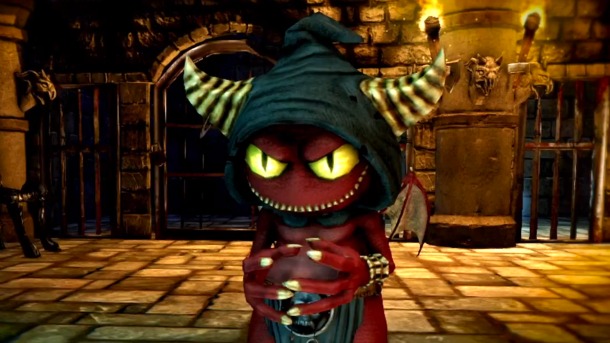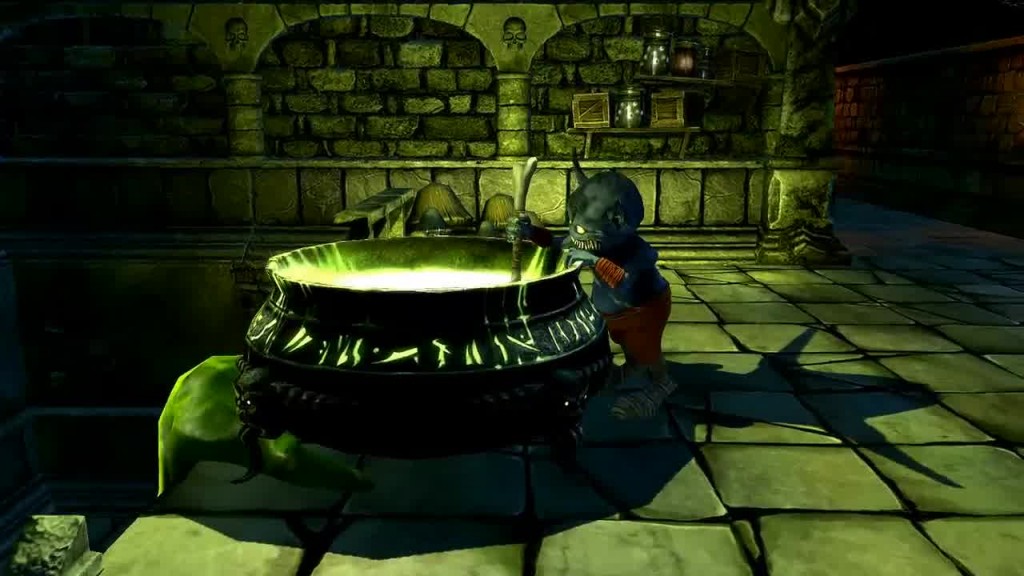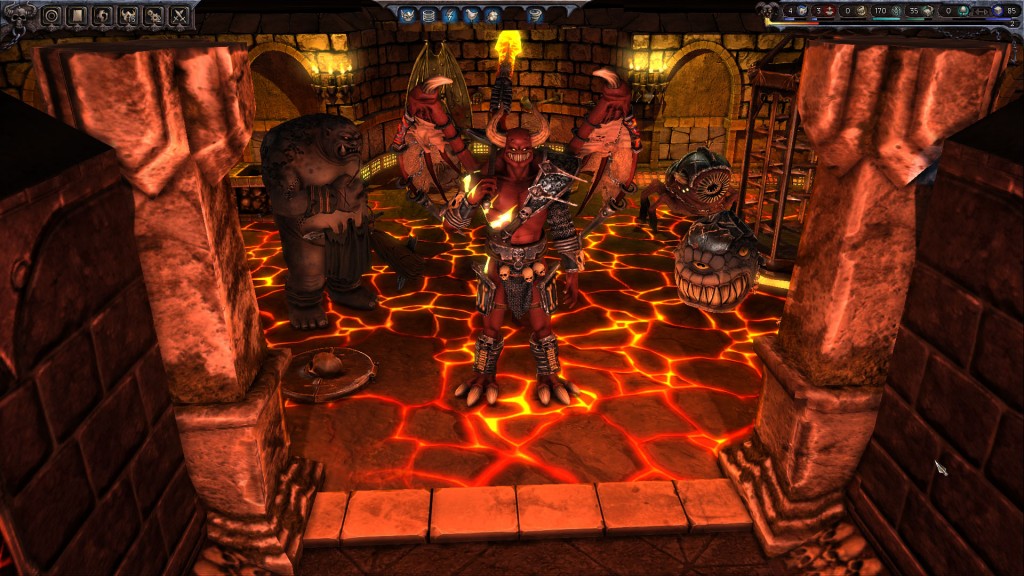
Genre: Dungeon management, real time strategy
Developer: Cynide Studios
Publisher: Paradox interactive
Platform: Microsoft Windows
Impire- Review
Dungeons have something creepy about them. This is only natural seen their function. The whole torture, torment and deprave principle just doesn’t work for everybody. Except for those doing the torturing, tormenting and depraving. Evildoers of the highest caliber have dungeons with treasures and minions to protect them. Paradox Interactive has given us the opportunity to be such an evil dungeon lord. In Impire you will experience firsthand how tedious and rewarding it can be to have your own dungeon. Will it be one hell of a ride or just another ride to hell?
Story
You are Ba´al Abbadon, mighty ruler of the pit, the purest of the impure, fearsome and without mercy. You have been summoned by Oscar Van Fairweather a, not so capable, demonologist with grand plans. He needs your help with conquering the continent of Ardania. This task would have been easy, was it not for the fact that due to a mishap (bluntly: Oscar’s incompetence) Ba’al has been summoned in a rather imperfect form. Of course Ba’al wants to return to his former imposing self, so he decides to help Fairweather out, be it out of pure self-interest. Little do the people of Ardania know of their impeding doom…
The story of impire is fairly simple. It’s akin to a quest for heroes, except that now it’s about the bad guy’s quest for total domination. Factor in numerous groups of shady individuals like: a death priestess, an ancient (and very angry) serpent goddess and various heroes who are out for your treasure. All these make the story interesting to a point that the nature of real time strategy- (RTS), or more precisely dungeon management- games, get in the way of enjoying it.
The narrative is witty and surely an attention catcher. The many references to metal and rock (as a musical genre) will surely please the metal fans(like myself) out there.
Characters in impire follow very classic character designs. The bumbling mastermind (Oscar) and his, more than capable, henchman (Ba’al ). During the development of the story other classic characters like the crazy scientist, proud warrior king and vengeful succubus show up to make the party more interesting. While this kind of classic design might not be innovative, it still fits the game perfectly.
The only gripe one would have about the game is the fact that the side-quests are plenty. Game-wise this might be a good thing, but there were times where the side-quests popped up so fast that the difference between side-quest and main-quest became blurry. It is here where the classic characters clash with the modern way of storytelling. It is also here where the whole story itself, gets blurry.
 This review contains a number of words with “imp”. Why don’t you count them?
This review contains a number of words with “imp”. Why don’t you count them?
Graphics
The character design of impire is another fine example that simple is not bad, as long as it fits. The characters are designed not to frighten you but are more on the funny, might I even say on the cute side. There is enough detail on them to make them memorable. It is necessary to mention at this point that there are no changing facial expressions in impire. The character faces are static and set in a, for character or unit, unique grimace. Expressions and emotions are conveyed by simple shaking heads and changes in posture.
The dungeon and surrounding areas are detailed and pleasing to the eye. Certain parts of the dungeon are illuminated by eerie lights. This contrast between light and dark gives your dungeon an almost magical feel to it. Like the characters themselves, the background and areas are static (if not more). The manqué of moving elements is in this case more forgivable, since backgrounds aren’t supposed to be moving (too much).
There are times when you have to send your squads out in the wild for various reasons (resources, quests etc…). While the inclusion of a world map is a nice thing, I personally felt that the designers could have just given us a realistic medieval map instead of a poorly animated landscape. This is probably just a matter of preference and nit-picking.
A rather simplistic approach to character modeling makes impire nothing outstanding when it comes to the graphics department. Thankfully the designs are so well made, that aforementioned problems are easily forgotten.
Sound
I’m a little bit torn when it comes to the sound of impire. The voice acting is spot on, superb even in my books. Earlier I mentioned that the characters possess little to no facial animations. Here is where the voice acting becomes important. Angry or flabbergasted, each of these emotions is perfectly conveyed by the voice actors. Impire is one of the few games that can match the quality of a good storyteller cassette. Even standard character models are made unique just by the voice acting alone.
There is a part about impire’s sound that I feel, could have been easily avoided by the developers. The standard units in the game are dead silent! No grunts, no screaming, the only sound that they make are battle-related sounds. Clashing of swords, spitting of fire and the breaking of shields are the only sounds audible while your imps remain stoic. A stark contrast to the lively main cast, which is almost exclusively brought to live by sound. It should be standard now that grunts give off grunts. Even if it’s just 3 sounds per grunt-class, this alone would have made impire a more enjoyable experience (don’t get me wrong, I am positively hooked on the game).
Gameplay
Impire is of the dungeon management genre. As the name not so subtly implies, the player deals most of the time with managing a dungeon. This includes finding resources, staving off heroes and making sure your staff is well fed.
In story mode, the player often starts with a broken mushroom den, a storage room and a treasure pit. The mushroom den provides mushrooms, which with the help of the storage room can be stored. Once stored, materials can be acquired by converting a certain amount of harvested mushrooms into materials. Both mushrooms and materials are used to acquire and upgrade certain units. At the beginning of the game one also has control over Ba’al, who is necessary to summon workers. Workers are essential in building, digging and they make rooms functional (more to this later). They also repair rooms by creating a vortex. This is done by dancing the “limbo”. The animation of this is a must-see for everyone who loves scary critters doing extremely cute things.
Before you can start building different rooms and units, you have to unlock them first. This is done by DEC points. DEC points are acquired by fulfilling certain requirements, for example: by building a certain unit, you can get a DEC point. It sounds simple enough, but upgrades need to be found first. This is done by finding them as runes during missions.
Each room in impire fulfills a certain function, the most important, although not the most useful, is the treasure room. The treasure room is the one room in your whole dungeon that you cannot allow to be destroyed (in-game it’s called “plundered”). If it does happen, that heroes manage to destroy your treasure room, you lose the game. Other notable rooms are the kitchen and the DEC-extractor room. Whilst the kitchen is necessary to heal and replenish the aggressiveness of your unit, the DEC-extractor room provides you with necessary DEC-points (in a very gruesome way).
Some rooms need workers to occupy them to be functional (a kitchen needs a cook right?), this is best kept in mind at the beginning of the game, when the maximum number of workers is still low.
So far everything seems to be standard. The units seem to be continuing this trend at first sight, but at closer examination, one will find that there is more to them. Mixing units is the key for a successful squad. Most of the time one would go for the strongest units when building a squad. But in impire, implementing variety will give your squad extra abilities depending on which units you have mixed.
It’s also the units where you will use all the micro management skills you have. Each unit needs to be individually upgraded and told what to do. This can be circumvented by placing them into squads, but even then one still needs to upgrade each squad member individually. While some players don’t like this kind of hassle, I think it keeps players busy. It is positively a good thing, I found myself absorbed in everythin g that had to be done. For less experienced players, this might be boring and a reason to avert from impire, but seasoned veterans will probably welcome the challenge.
There is one little flaw about the upgrades, they consume 5 materials but this is nowhere indicated. I suddenly found myself running out of materials at one point of the game and I didn’t even know why.
The consequences of a sudden lack of materials during a battle are usually disastrous. So the developers could have kept this in mind. A simple number would have been of tremendous help, during the decision making process of the use of resources.
Units have besides the normal health bar, a bar indicating their aggressiveness. Idle units will slowly build up aggressiveness, whereas patrolling units usually loose aggressiveness. One would wonder why units would be put on patrol then, but the answer is simple: heroes regularly try to invade your dungeon and patrolling units naturally cover more ground than stationary units. Units can be ordered to follow Ba’al, in this case they don’t lose any aggressiveness.
Ba’al himself is also a playable character. During the course of the game, Ba’al can be upgraded and by doing so he gradually grows to his hellish impressive old self. At a certain point of Ba’al’s evolution, the player must choose if Ba’al will develop in either a mage, warrior or commander type of demon. Each class has different abilities and adds some variety in game-play. Although not necessarily relevant for the story, it is nice to see that the developers went the extra mile.
Missions are mostly linear, meaning there is a main-objective and multiple side-quests. Side-quests are mostly just another way of acquiring needed resources or outside help. Each mission objective is introduced by a short narrative of Oscar. It is here where one major flaw is located. The mission briefing is only mentioned once. This means that one has to pay a maximum amount of attention, lest he or she forgets the tip given to solve the mission. I remember in one mission I had to unlock a room by solving a color coded puzzle. The color combination was given to me via a simple riddle. A single distracted moment made it impossible for me to open the room. The inability to listen or read the explanation again, forced me to restart the level.
Conclusion
Impire is probably the best dungeon management game that has come out in a long time. While the story is nothing special and almost linear, it is commendable that this is done flawlessly. The voice acting is on the spot, at least for the main cast. Micro- management has never been this much fun, since well… ages (in my opinion). Impire keeps you busy and interested from start to finish. Complaints about repetitiveness of the game might be founded, but I think it is more of a matter of preference. It is true that there are a couple of imperfections that should (and could be easily) addressed. The lack of grunt noises and the inability to be able to re-check the mission goals, are flaws that can be frustrating at times. The biggest imperfection is perhaps the lack of information when it comes to upgrading units. A micro-management oriented game is not as pleasant to play when the necessary information is missing.
But in the end Impire is a captivating game, unique characters and funny dialogues are more than enough to recommend it to everybody. A herd of (almost) impervious, impertinent, imps are waiting to serve their overlord. So what are you waiting for? You’re supposed to be on a highway to hell!
Impire- Review,






No Comments